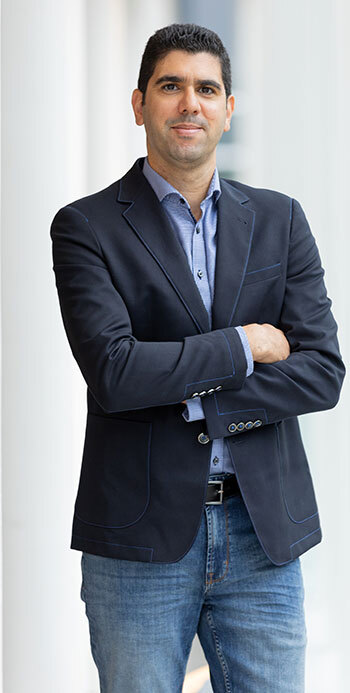Connecting the World through the Heavens!

Purchased from Gettyimages. Copyright.
“The ultimate goal is for everyone to be able to connect anywhere on the planet!” says Wael Jaafar, Associate Professor in the Department of Software Engineering and Information Technology at ÉTS.
Specializing in wireless communication networks, Dr Jaafar has developed expertise in 5G and 6G non-terrestrial networks. Drones, satellites, balloons—high-altitude platforms (HAPS)—these flying objects carry the future of communication. “With this technology (HAPS), we will be able to connect a cell phone to a stationary platform 20 kilometres above Earth rather than through a satellite orbiting at an altitude of 400 kilometres,” explains Professor Jaafar.
From a Commodore to a Stratospheric Balloon
Dr Jaafar discovered computers as a teenager while programming games on old Commodore computers at the Maison de la Culture, where his father worked. This passion led him instinctively to study at the École Supérieure des Communications of Tunis, in Tunisia. During his final year internship, young Wael decided to look into what was being done abroad. He selected the University of Quebec in Montréal, where he met Professor Wessam Ajib, who inspired him to pursue a career in telecommunications, specifically in the field of wireless networks.
Armed with a Bachelor’s in Telecommunications Engineering, Wael received a government scholarship to complete his studies in Canada, this time at Polytechnique Montréal, where he earned a master’s degree and a PhD in Electrical Engineering. His thesis focused on cognitive radio networks that facilitate the joint use of frequency bands by primary and secondary networks. Dr Jaafar’s research has always been related to cooperative techniques in the field of communications, even to this day.
A Stint in Industry, Sowing for the Future
After many years of studies, Wael Jaafar felt the need to put his knowledge to the test in a real environment. He accepted a position as Consulting Engineer at SNC-Lavalin in the Telecommunications Division. He honed his project management skills for four years and established relationships with international clients. However, Dr Jaafar realized that an industry researcher has a limited horizon: “I find that things move very slowly.”
He missed the research environment and discussions with students. He contacted his professor Wessam Ajib who encouraged him to pursue a postdoctoral fellowship at UQAM, but in computer science rather than electrical engineering. “By stepping out of my comfort zone, I discovered complementary aspects of managing communications networks, including data storage, caching, and computing, and also the use of artificial intelligence, which will serve me well in my projects.”
Eye to the Sky
 A few months later, an NSERC postdoctoral fellowship allowed Dr Jaafar to join Professor Halim Yanikomeroglu and his team at Carleton University in Ottawa. His meeting with Prof. Yanikomeroglu, a leading expert in non-terrestrial network technology, inspired Wael to cross the threshold into a new world of drones and airborne platforms. Dr Jaafar had found his calling.
A few months later, an NSERC postdoctoral fellowship allowed Dr Jaafar to join Professor Halim Yanikomeroglu and his team at Carleton University in Ottawa. His meeting with Prof. Yanikomeroglu, a leading expert in non-terrestrial network technology, inspired Wael to cross the threshold into a new world of drones and airborne platforms. Dr Jaafar had found his calling.
In the form of helium-filled balloons or solar-powered aircraft, these aerial stations equipped with phenomenal data storage and computing capacity cover a footprint between 20 and 100 kilometres. “With a few dozen balloons, you can serve all of Japan,” says enthusiastic Dr Jaafar.
Prof. Jaafar believes this is the easiest way to connect the three billion digitally excluded people living in remote areas and scattered villages. In addition, these stratospheric balloons will help in rescuing people in distress.
Balloons for Disaster-Stricken Areas
Prof. Jaafar is part of a group focusing on public safety technologies. “Connectivity via these platforms will be inevitable in the near future in both urban and rural under-covered areas,” Dr Jaafar predicts. When earthquakes or other disasters occur and ground infrastructures collapse, help can only come from the sky, from balloons equipped with artificial intelligence to guide rescue workers and restore communications.
ÉTS and Industry, Achieving Projects Together
Wael Jaafar has a lot to pass on to his students. Sharing his hypotheses and his experiences and encouraging reflection can only contribute to raising awareness of social issues among future engineers. “Sometimes the right solution is not the best one, but the one that fits the situation.” If Dr Jaafar chose to teach at ÉTS, it is because the school’s links with industry facilitate the development of promising projects.
Using Existing Resources in Synergy
Over the next few years, Prof. Jaafar will focus on the synergy between terrestrial and non-terrestrial networks. He believes in the importance of optimizing existing resources and combining them with new technologies for aerial platforms. The world may have a better chance of getting along when heaven and Earth connect.



